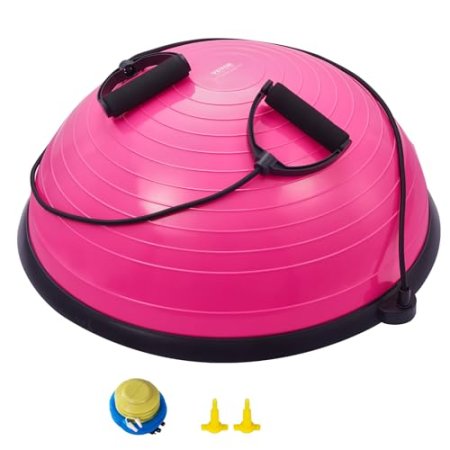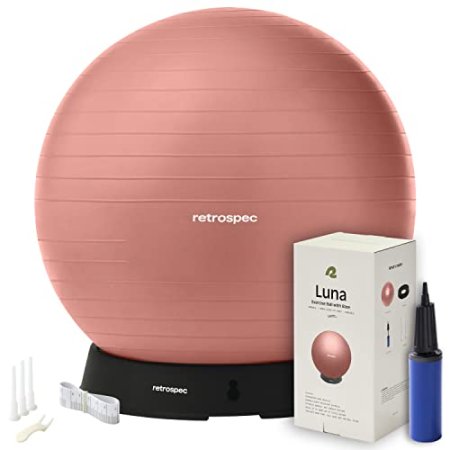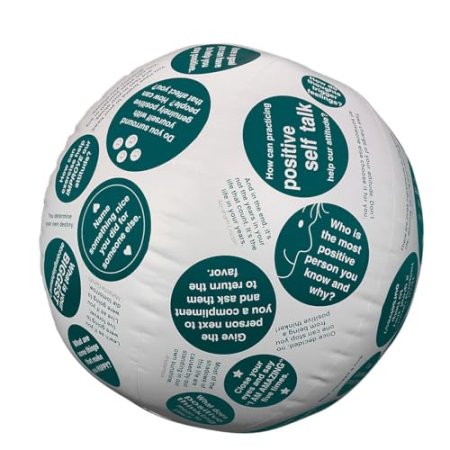The Comprehensive Guide to Exercise Balls & Accessories
Introduction to Exercise Balls & Accessories
Exercise balls, also known as stability balls or Swiss balls, have become a staple in fitness routines due to their versatility and effectiveness. They are used for a variety of exercises, from core strengthening to flexibility training. In addition to the balls themselves, numerous accessories enhance their use and provide more options for workouts. This guide will explore the benefits, types, and accessories associated with exercise balls to help you optimize your fitness routine.
What Are Exercise Balls?
Exercise balls are large, inflatable spheres used to improve balance, strength, and flexibility. They come in various sizes and can be adjusted to different levels of inflation, providing versatility for different exercises and fitness levels. The core concept of an exercise ball is to engage your stabilizing muscles by forcing your body to maintain balance while performing exercises.
Benefits of Using Exercise Balls
Enhanced Core Strength
Exercise balls are excellent for strengthening your core muscles. Exercises performed on the ball, such as crunches or planks, require your abdominal muscles to work harder to stabilize your body. This leads to improved core strength and stability.
Improved Balance and Coordination
Using an exercise ball challenges your balance and coordination. The instability of the ball forces your body to adjust and stabilize, which enhances overall balance and coordination. This is beneficial not only for fitness enthusiasts but also for individuals recovering from injuries.
Increased Flexibility
Exercise balls can be used for stretching exercises that promote flexibility. The ball supports your body while you stretch, allowing for a greater range of motion and deeper stretches. This can help improve flexibility and reduce muscle tension.
Types of Exercise Balls
Standard Exercise Balls
Standard exercise balls are the most common type and come in various sizes, typically ranging from 45 cm to 75 cm in diameter. They are used for a wide range of exercises, including core workouts, stretching, and balance training.
Anti-Burst Exercise Balls
Anti-burst exercise balls are designed to be more durable and resistant to punctures. They are made from thicker material and are ideal for high-intensity workouts. If the ball is accidentally punctured, it deflates slowly rather than bursting suddenly.
Yoga Balls
Yoga balls are similar to standard exercise balls but are often used in conjunction with yoga practices. They are available in various sizes and can be used for a range of yoga poses and stretches.
Choosing the Right Exercise Ball
Size Matters
Choosing the correct size of exercise ball is crucial for comfort and effectiveness. Generally, your height determines the appropriate size. For example, if you are between 5'1" and 5'7", a 55 cm ball is typically recommended. Taller individuals might need a 65 cm or 75 cm ball.
Check for Quality
Ensure the exercise ball is made from high-quality, durable materials. Look for balls with a high weight capacity and anti-burst features to ensure safety and longevity.
Inflation and Deflation
The ball should be properly inflated to provide the right level of firmness. Over-inflation or under-inflation can affect the effectiveness of your exercises and may lead to discomfort or instability.
Popular Exercise Ball Accessories
Ball Pumps
A ball pump is essential for inflating your exercise ball. Manual pumps and electric pumps are available, with electric pumps offering quicker and easier inflation.
Ball Stands
Ball stands keep your exercise ball in place when not in use. They prevent the ball from rolling around and can also make it easier to sit on the ball when using it for exercises.
Exercise Ball Bases
Exercise ball bases are rings or platforms that provide additional stability. They help keep the ball in place during exercises and can be especially useful for beginners or those recovering from injuries.
Ball Covers
Ball covers are protective layers that can be added to your exercise ball. They help protect the ball from damage and make it easier to clean. Covers often come in various colors and designs to match your workout space.
Using Exercise Balls for Different Types of Workouts
Core Workouts
Exercise balls are fantastic for core workouts. Exercises like ball crunches, planks, and mountain climbers target the abdominal muscles and improve overall core strength.
Strength Training
Incorporate exercise balls into your strength training routine. Use the ball as a support during exercises like push-ups or squats to engage your core and improve stability.
Flexibility and Stretching
Exercise balls are great tools for stretching exercises. Perform stretches such as seated forward bends or chest openers using the ball to enhance flexibility and reduce muscle tension.
Rehabilitation and Injury Prevention
Exercise balls are commonly used in rehabilitation settings. They can help improve balance, strengthen stabilizing muscles, and aid in recovery from injuries. Always consult with a healthcare professional before using exercise balls for rehabilitation purposes.
Safety Tips for Using Exercise Balls
Check for Damage
Regularly inspect your exercise ball for any signs of wear or damage. Ensure there are no punctures or tears that could lead to a sudden deflation.
Use on a Non-Slip Surface
Perform exercises on a non-slip surface to prevent the ball from slipping. Using a mat or carpeted area can provide additional grip and stability.
Maintain Proper Inflation
Ensure the ball is inflated to the correct level. Over-inflation or under-inflation can affect balance and the effectiveness of exercises.
Common Mistakes to Avoid
Using Incorrect Size
Using an exercise ball that is too large or too small can lead to discomfort and reduced effectiveness. Make sure to choose the right size based on your height and fitness needs.
Neglecting Warm-Up and Cool-Down
Always warm up before starting your workout and cool down afterward. Stretching and warming up help prevent injuries and prepare your body for exercise.
Ignoring Proper Form
Maintaining proper form during exercises is crucial. Incorrect form can lead to injuries and reduce the benefits of your workout. Refer to instructions and practice proper technique.
Maintaining Your Exercise Ball
Regular Cleaning
Clean your exercise ball regularly to maintain hygiene. Use mild soap and water, and avoid harsh chemicals that could damage the ball.
Proper Storage
Store your exercise ball in a cool, dry place away from direct sunlight. Avoid exposing it to sharp objects or extreme temperatures.
When to Replace Your Exercise Ball
Replace your exercise ball if it shows signs of significant wear, such as cracks, severe fading, or loss of firmness. Regularly assess the condition of your ball to ensure safety during use.
FAQs About Exercise Balls & Accessories
What are the benefits of using an exercise ball?
Exercise balls enhance core strength, balance, and flexibility. They provide a versatile workout tool for various exercises, improving overall fitness and stability.
How do I choose the right size exercise ball?
Choose an exercise ball based on your height. Typically, a 55 cm ball is suitable for individuals between 5'1" and 5'7", while larger sizes are available for taller individuals.
What accessories are essential for using an exercise ball?
Essential accessories include a ball pump for inflation, a ball stand or base for stability, and a ball cover for protection and easy cleaning.
Can exercise balls be used for rehabilitation?
Yes, exercise balls are commonly used in rehabilitation to improve balance, strengthen stabilizing muscles, and aid in recovery. Consult a healthcare professional for specific rehabilitation exercises.
How do I maintain and clean my exercise ball?
Clean your exercise ball with mild soap and water, and store it in a cool, dry place. Regularly inspect the ball for damage and replace it if necessary.
Conclusion
Exercise balls and accessories are invaluable tools for enhancing your fitness routine. They offer a wide range of benefits, from improved core strength to increased flexibility. By selecting the right ball and accessories, using them effectively, and maintaining proper care, you can optimize your workouts and achieve your fitness goals. Whether you're a fitness enthusiast, a beginner, or someone in rehabilitation, exercise balls provide a versatile and effective solution for a healthier, more balanced body.
































